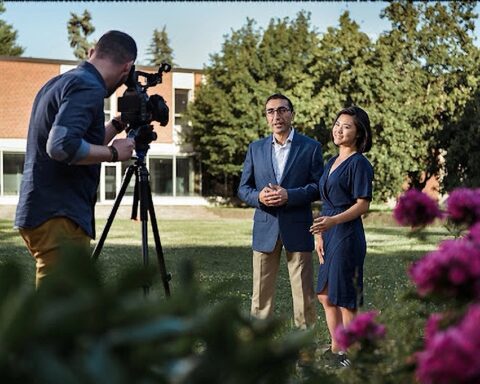![]() Welcome to the debate about the debates.
Welcome to the debate about the debates.
The world of federal election leaders’ debates as we know it went kaboom last week, when the Conservatives walked away from an understanding with the Big Three television networks for four debates during the fall campaign, two in English and two in French.
Instead, the Tories announced they’d accepted invitations for two debates — from Maclean’s magazine and Rogers TV in English, and Quebec’s TVA network in French. Both might be in August, before the writ for the October election is even dropped. Conservative campaign spokesman Kory Teneycke said the party would accept at least three more debates, two in English and one in French.
In the first news cycle after the story broke, the mainstream media were mostly shocked and appalled. What was Stephen Harper, famous for his head-games, up to in apparently dissing the TV consortium? Was he trying to suppress voter turnout by abandoning mass media in favour of niche channels where Conservatives could reach their target audience?
[T]his event has underlined that the consortium is actually a cartel. Other media have suddenly got that, in that they can also offer to host debates. For example, if iPolitics happened to host one, it wouldn’t be on television, but it would be live-streamed on the Internet.
But then, the free market kicked in, and all kinds of media organizations offered to host leaders’ debates. Game on. Bloomberg News and the Globe and Mail were among them, and they’re not even in the television business. But they can produce live streaming video on the Internet. And from there, it’s just a posting to YouTube, Twitter and Facebook. Welcome to the digital world. The modern, 21st century world.
The network consortium — CBC/Radio-Canada, CTV and Global — pushed back with a statement that 10 million people watched the English debate in 2011 and four million the French one.
On CTV’s Question Period Sunday, host Bob Fife asked Teneycke why he would trade that for Rogers’ audience of just 300,000 on six local stations. To which Teneycke replied that the Big Three would be invited to cover the debate, and assumed they would. In this, the Conservatives are not alone. The NDP has accepted the same two invitations. The Liberals are ambivalent, promising that if elected they’d create an independent debates commission as in the United States.
It isn’t just the debate hosts and formats that are changing in Campaign 2015, but coverage of the leaders’ tours — there may well be a lot less of it.
In last year’s Quebec election, TVA went it alone and shook up the traditional format by offering one-on-one segments. That probably plays to Harper’s and Tom Mulcair’s strengths as seasoned debaters. As for Justin Trudeau, he would win simply by exceeding low expectations. TVA would obviously invite Bloc Québécois Leader Mario Beaulieu, though it’s not clear whether it would include Green Party Leader Elizabeth May.
The consortium is suggesting they may go ahead with debates anyway, with Harper represented by a metaphorical empty chair. Yeah, right, try that with a guy who would be regulating your business if he won again. Hello, head office. Still, it’s an interesting game of chicken.
Adapting Debates to a Changing Media Landscape
The events of last week have also served to remind some in the media of the consortium’s accumulated sense of entitlement and exclusivity. They decide whether other parties are invited to debate; they determine the moderator and participants from their own networks; they choose the questions, including the video questions from ordinary voters. There was no transparency or disclosure in this, the consortium alone decides.
The Conservatives are obviously walking away from the consortium for their own reasons, and the least that can be said is that they are not disinterested. They want to reach their own audience, and in the title of Susan Delacourt’s excellent book, they are Shopping for Votes.
But this event has underlined that the consortium is actually a cartel. Other media have suddenly got that, in that they can also offer to host debates. For example, if iPolitics happened to host one, it wouldn’t be on television, but it would be live-streamed on the Internet. The audience might include my 24-year-old daughter. She and her friends don’t watch TV, but get all their information online.
You won’t need to pay $10,000 a week to cover a GTA campaign, all you’ll need is the leaders’ itineraries and a car.
It isn’t just the debate hosts and formats that are changing in Campaign 2015, but coverage of the leaders’ tours — there may well be a lot less of it.
It’s a question of cost and content.
It’s very expensive for media outlets to fly on leaders’ tours — a minimum of $10,000 per week. For a network television crew of three, that’s $30,000 per week over five weeks, times the three major tours.
For a newspaper, it costs $150,000 to cover the three major party tours; for a network the cost is upwards of $500,000.
In today’s cost conscious media environment, that’s a lot of money. And what do they get for it? Scripted tours that are as boring as the rain. Typically, a leader’s day begins with a media availability, followed by a photo op at a plant or daycare, followed by a speech to a chamber of commerce, followed by supper hour TV and radio interviews, wrapping up with a partisan party rally in the evening.
What if the networks decided to split the costs of a pool camera, and shoot their standups from Parliament Hill? What if newspapers decided they were fine with reports from Canadian Press?
That would cause leaders’ tours to downsize in a hurry. It’s already happening in the U.S., where Democratic presidential front-runner Hillary Clinton set off for her first tour of Iowa in a seven-seat van, leaving the media to fend for themselves as they chased after her. Last week she was in Brooklyn, touring neighbourhood doorsteps and posing for selfies posted on Twitter. She doesn’t need a media entourage for that.
The Canadian campaign is going to be decided mainly in the Greater Toronto Area, with 25 seats in downtown 416, and 29 seats in suburban 905. Those 54 seats make the GTA the third largest province in the country after Ontario and Quebec.
You won’t need to pay $10,000 a week to cover a GTA campaign, all you’ll need is the leaders’ itineraries and a car.
L. Ian MacDonald is editor of Policy, the bi-monthly magazine of Canadian politics and public policy. He is the author of five books. He served as chief speechwriter to Prime Minister Brian Mulroney from 1985-88, and later as head of the public affairs division of the Canadian Embassy in Washington from 1992-94.
Published in Partnership with ipolitics.ca





